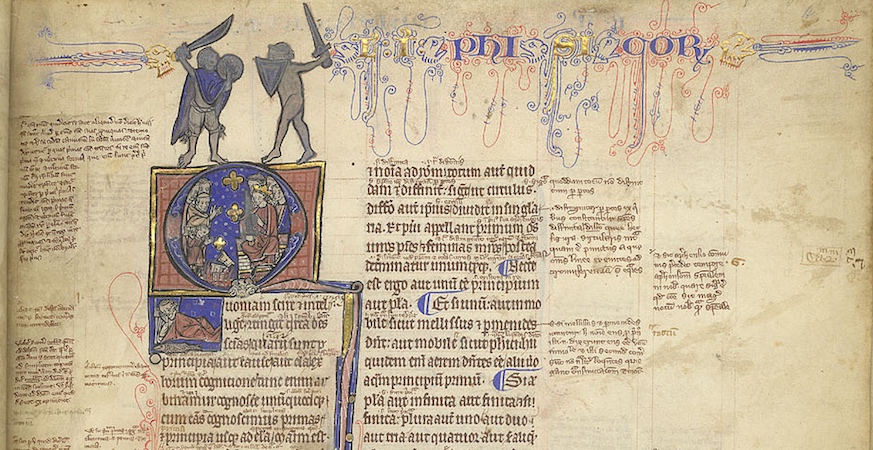- Feb 2023
-
atecopol.hypotheses.org atecopol.hypotheses.org
-
www.reddit.com www.reddit.com
-
Are there symbols for 'supported by' or 'contradicted by' etc. to show not quite formal logical relations in a short hand?
reply to u/stjeromeslibido at https://www.reddit.com/r/Zettelkasten/comments/10qw4l5/are_there_symbols_for_supported_by_or/
In addition to the other excellent suggestions, I don't think you'll find anything specific that that was used historically for these, but there are certainly lots of old annotation symbols you might be able to co-opt for your personal use.
Evina Steinova has a great free cheat sheet list of annotation symbols: The Most Common Annotation Symbols in Early Medieval Western Manuscripts (a cheat sheet).
More of this rabbit hole:
- Steinová, Evina. Notam Superponere Studui: The Use of Annotation Symbols in the Early Middle Ages. Brepols, 2019.
- Cappelli, Adriano. The Elements of Abbreviation in Medieval Latin Paleography. University of Kansas Libr., 1984.
- Coulson, Frank, and Robert Babcock. The Oxford Handbook of Latin Palaeography. Oxford University Press, 2020.
- Lindsay, W. M. Notae Latinae. Cambridge University Press, 2013. https://archive.org/download/notaelatinaeacco00lindrich/notaelatinaeacco00lindrich.pdf.
- Bains, Doris. A Supplement to Notae Latinae (Abbreviations in Latin Mss. of 850 to 1050 A.D.). Cambridge [England] University Press, 1936. http://archive.org/details/supplementtonota0000bain.
(Nota bene: most of my brief research here only extends to Western traditions, primarily in Latin and Greek. Obviously other languages and eras will have potential ideas as well.)
Tironian shorthand may have something you could repurpose as well: https://en.wikipedia.org/wiki/Tironian_notes
Some may find the auxiliary signs of the Universal Decimal Classification useful for some of these sorts of notations for conjoining ideas.
Given the past history of these sorts of symbols and their uses, perhaps it might be useful for us all to aggregate a list of common ones we all use as a means of re-standardizing some of them in modern contexts? Which ones does everyone use?
Here are some I commonly use:
Often for quotations, citations, and provenance of ideas, I'll use Maria Popova and Tina Roth Eisenberg's Curator's Code:
- ᔥ for "via" to denote a direct quotation/source— something found elsewhere and written with little or no modification or elaboration (reformulation notes)
- ↬ for "hat tip" to stand for indirect discovery — something for which you got the idea at a source, but modified or elaborated on significantly (inspiration by a source, but which needn't be cited)
Occasionally I'll use a few nanoformats, from the microblogging space, particularly
- L: to indicate location
For mathematical proofs, in addition to their usual meanings, I'll use two symbols to separate biconditionals (necessary/sufficient conditions)
- (⇒) as a heading for the "if" portion of the proof
- (⇐) for the "only if" portion
Some historians may write 19c to indicate 19th Century, often I'll abbreviate using Roman numerals instead, so "XIX".
Occasionally, I'll also throw drolleries or other symbols into my margins to indicate idiosyncratic things that may only mean something specifically to me. This follows in the medieval traditions of the ars memoria, some of which are suggested in Cornwell, Hilarie, and James Cornwell. Saints, Signs, and Symbols: The Symbolic Language of Christian Art 3rd Edition. Church Publishing, Inc., 2009. The modern day equivalent of this might be the use of emoji with slang meanings or 1337 (leet) speak.
Tags
- paleography
- Medieval texts
- shorthand
- Curator's Code
- annotation symbols
- reply
- leet speak
- Tironian shorthand
- emoji
- hat tip
- Evina Steinova
- ars memoria
- Tina Roth Eisenberg
- symbology
- nanoformats
- Maria Popova
- note taking affordances
- via
- Universal Decimal Classification
- manuscript studies
Annotators
URL
-
-
abbreviationes.net abbreviationes.net
- Apr 2022
-
-
An initial stage of annotation might be provided bya professional reader hired to add aids to reading for the owner, including espe-cially mnemonic or meditative aids, or enhancements to the layout, but alsooccasionally self-reflexive or potentially dissenting observations.24 A successionof owner-readers could then add further corrections and comments.
Stages of annotation in the medieval period
When is Hypothes.is going to branch out into the business of professional readers to add aids to texts?! :)
Link this to the professional summary industry that reads books and summarizes them for busy executives
Link this to the annotations studied by Owen Gingerich in The Book Nobody Read.
-
- Oct 2021
- Sep 2021
-
fs.blog fs.blog
-
Most of us were taught as children to treat books as something sacred—no folding the page corners, and no writing in the margins, ever.
Most Medieval manuscripts specifically left wide columns of space to encourage readers to mark up their texts.
cross reference: Medieval notepads - Khan Academy
 <small>Detail, London, British Library, Harley MS 3487 (13th century)—[source](http://www.bl.uk/catalogues/illuminatedmanuscripts/ILLUMIN.ASP?Size=mid&IllID=16790)</small>
<small>Detail, London, British Library, Harley MS 3487 (13th century)—[source](http://www.bl.uk/catalogues/illuminatedmanuscripts/ILLUMIN.ASP?Size=mid&IllID=16790)</small>
-